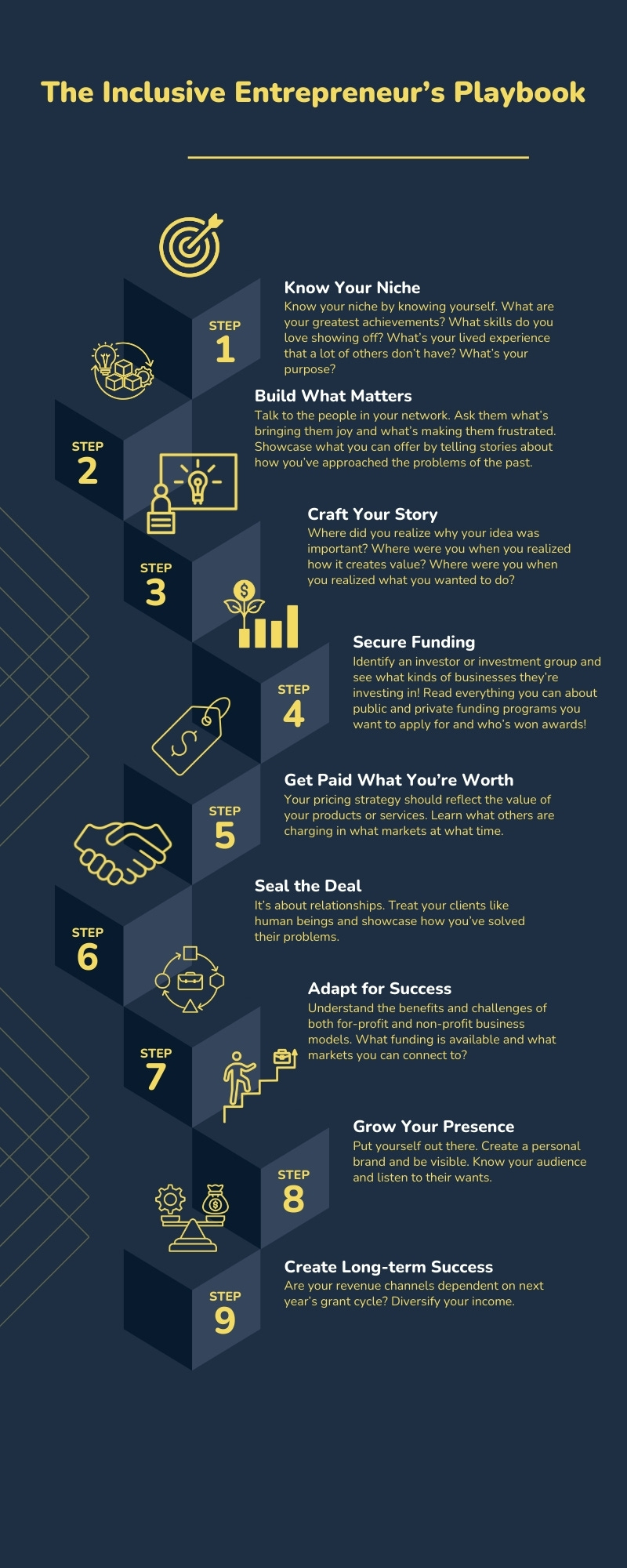The Inclusive Entrepreneur’s Playbook
Turning Ideas into Income
Use my step-by-step guide to make your inclusive ideas a reality. My playbook offers 9 practical steps to help you transform your passion for inclusion into successful products and services.
Step 1: Know Your Niche
Know your niche by knowing yourself. Maybe you’ve heard of the Japanese philosophy of Ikigai. I’ve come up with my own version… What are your greatest achievements? What skills do you love showing off? What’s your lived experience that a lot of others don’t have? What’s your purpose? Knowing your niche helps you tailor your offerings and makes it easier to connect with your audience.
Step 2: Build What Matters
Turn your ideas into tangible products or services that address real needs. Talk to the people in your network. Ask them what’s bringing them joy and what’s making them frustrated. Showcase what you can offer by telling stories about how you’ve approached the problems of the past.
Step 3: Craft Your Story
A compelling pitch clearly communicates your vision and the impact of your work. Adapt Simon Sinek’s “Start with Why” to include your Where! Where did you realize why your idea was important? Where were you when you realized how it creates value? Where were you when you realized what you wanted to do?
Step 4: Secure Funding
Connect with impact investors and learn how to secure the necessary funding to grow your business. Understanding what investors are looking for can help you tailor your pitch and proposals effectively. Do your research! Identify an investor or investment group and see what kinds of businesses they’re investing in! Want to go for public or private funding? Advice remains the same. Read everything you can about the programs you want to apply for and who’s won awards!
Step 5: Get Paid What You’re Worth
Your pricing strategy should reflect the value of your products or services. Effectively monetizing your work will keep your business sustainable, and knowing what others are charging in what markets at what time can help you build a sustainable business.
Step 6: Seal the Deal
Attracting and retaining clients is not about sales. It’s about relationships. You won’t close deals because you’ve force-fed your clients all of your marketing materials. But you will close deals if you treat your clients like human beings and showcase how you’ve solved their problems.
Step 7: Adapt for Success
Sometimes you need to transition between for-profit and non-profit business models in order to get to your goal. Understanding the benefits and challenges of each model is tricky. Ultimately it comes down to what funding is available and what markets you can connect to.
Step 8: Grow Your Presence
Building a sustainable career in the inclusion sector is about putting yourself out there. Having a personal brand lets you stay relevant and visible to potential clients and customers. It can feel super insecure at first. Knowing your audience and listening to their wants can help turn your insecurities into income.
Step 9: Create Long-term Success
Develop revenue channels that aren’t dependent on next year’s grant cycle. Diversifying your income sources can help you make it through changes in priorities for funders and keep your business going in the long run.
Key Takeaways
Put the Steps into Action: Follow each step methodically to build a strong foundation for your inclusive business.
Stay Flexible and Adaptable: Be ready to pivot and adapt your strategies as you learn and grow.
Focus on Financial Sustainability: Aim for long-term financial stability by diversifying your revenue streams.
Practice Makes Profit
Consistently applying these steps will lead you to success. The key to making your inclusive ideas profitable is consistent implementation.
P.S.
Not sure where to start? Sit down and set a timer for 30 minutes and reflect on your niche and the story you want to tell in your pitch!

